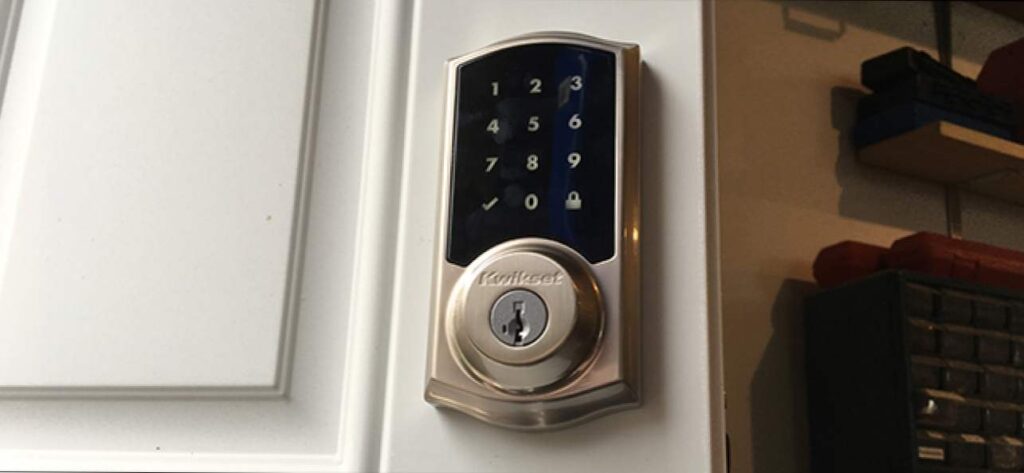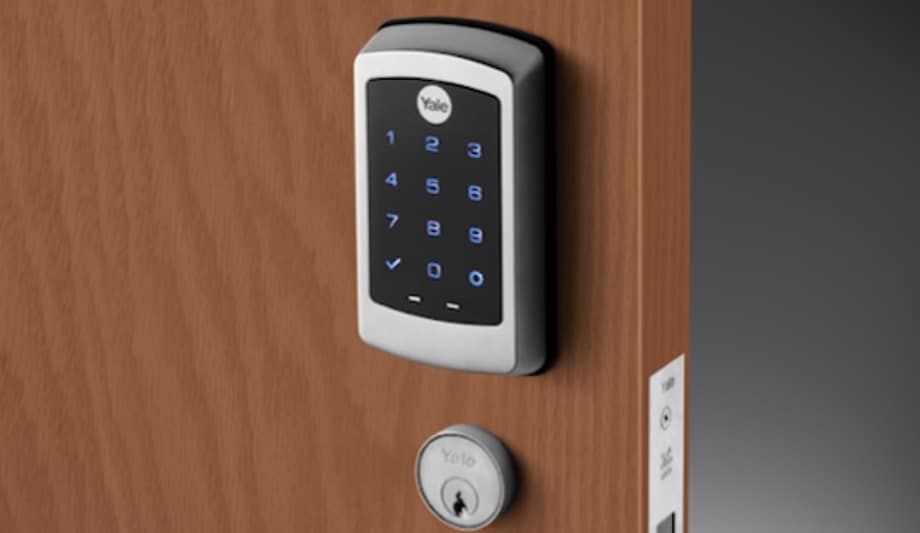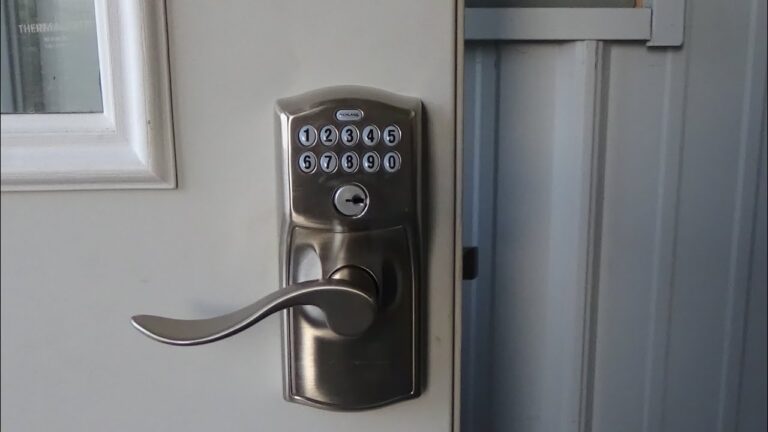Introduction
How To Install Keypad Door Lock: A keypad door lock is a practical and modern way to enhance your home’s safety while simplifying access for you and your loved ones. Say goodbye to fumbling for keys and worrying about misplaced or duplicated copies. Take you through process of installing a keypad door lock, ensuring that you can confidently secure your home without the hassle of traditional keys.
Whether you’re a seasoned DIY enthusiast or just looking to upgrade your home’s security, this guide will provide you with all the necessary information and instructions to successfully install a keypad door lock and enjoy the peace of mind that comes with it. By eliminating the need for physical keys and embracing personalized access codes, you’re taking a significant step towards enhancing both the security and accessibility of your living space.
Gone are the days of rummaging through your belongings to find your keys or worrying about the security implications of lost or copied keys. With a keypad door lock, you and your family can enjoy the freedom of entering your home using unique PIN codes, ensuring that only authorized individuals can gain entry. Whether you’re a tech-savvy homeowner or simply looking to streamline your daily routines, this guide will provide you with a clear and concise roadmap to effectively install your very own keypad door lock.

Are keypad door locks easy to install?
Installing Keyless Door Locks
If you have an existing deadbolt, installing the new lock can be as simple as removing it and sliding the new one into place. If you don’t yet have a deadbolt on your door, then the project gets significantly more complicated.
Manufacturers of keypad door locks understand that their customers range from experienced DIYers to homeowners with limited technical expertise. As a result, these locks are engineered to be user-friendly and straightforward to install. Many models come with comprehensive installation guides that provide step-by-step instructions, making it easier for individuals to follow along.
You don’t need an extensive toolkit or advanced technical skills to install a keypad door lock. Most installations can be completed with basic tools like a screwdriver and a measuring tape. The instructions provided by the manufacturer are usually clear and concise, allowing individuals to grasp the process quickly.
Many keypad door locks are designed to fit into pre-drilled holes, which are often the same size as those used for traditional deadbolt locks. This means that, in most cases, you won’t have to worry about major modifications to your door to accommodate the keypad lock. Additionally, standardized fittings and templates provided in the installation kit ensure proper alignment and placement.
Can I install my own door lock?
It never hurts to remove the old lock first and then take it with you to the hardware store to locate a match, or near match. Installing a new exterior door lock should take less than 15 minutes. Even for those that rarely do DIY home improvement projects. The instructions are fairly straightforward.
The complexity of installing a door lock can vary based on the type of lock you’re installing and your own familiarity with DIY projects. However, many modern door locks are designed with user-friendly installation in mind. Basic tools such as a screwdriver, measuring tape, chisel, and a drill might be needed, depending on the specific lock and door type.
Before diving into the installation process, it’s essential to read and understand the manufacturer’s instructions provided with the lock. This will give you a clear understanding of the steps involved and any specific requirements for your chosen lock.
The type of lock you’re installing plays a significant role in the complexity of the installation. Common types of locks include deadbolts, knob locks, lever locks, and keypad locks. Deadbolts and knob locks are relatively straightforward to install. While keypad locks might require a bit more attention due to their electronic components.
How much does it cost to install a keypad on a door?
Cost of Keypad Access Control Systems
Keypad entry systems range from $500 to over $1,500 per door and they need hardware to be installed on the outside of the building. Most keypad entry systems install quickly, but ultimately, it will depend on the wiring of your building.
The price of the keypad lock itself is one of the primary expenses. Keypad locks come in a range of styles, features, and brands, each with its own price point. Basic models without advanced features can start at around $50 to $100, while more advanced models with integrated smart technology or additional security features can range from $150 to $300 or more.
If you choose to hire a professional locksmith or handyman to install the keypad lock, labor costs will be a factor. Labor costs can vary based on your location, the complexity of the installation, and the rates of the professional you hire. On average, you might expect to pay anywhere from $100 to $300 for the labor involved in installing a keypad lock. However, this cost can be higher for more intricate installations or if additional adjustments to the door are required.
Installing the keypad lock yourself can significantly reduce costs, as you won’t need to pay for labor. Keep in mind that while DIY installation can be cost-effective. It’s important to have the necessary tools, skills, and patience to complete the installation correctly. DIY installation is generally more straightforward for basic keypad locks, while more complex locks might be better suited for professional installation.
Is it OK to lock your door?
Home and garage doors should always be locked. Almost 50% of burglars enter homes and property through unlocked doors and windows. Use your locks. Never leave keys outdoors.
Locking your doors provides a barrier that deters intruders and unauthorized individuals from entering your space. It’s the first line of defense against potential break-ins and ensures that only those with authorized access can enter.
A locked door significantly reduces the risk of theft and burglary. Intruders are less likely to attempt to enter a property that appears secure. Locking your doors, both when you’re at home and when you’re away, helps safeguard your valuables and personal belongings.
Locking your doors also grants you privacy and personal space. It ensures that you can have moments of solitude without the possibility of unexpected interruptions. This is especially important for maintaining your mental and emotional well-being.
Locking your doors provides peace of mind, allowing you to relax and focus on your tasks without worrying about potential security breaches. Knowing that you’ve taken steps to secure your environment contributes to an overall sense of safety.
Are keypad locks safe for house?
Or are they more secure than traditional locks? The answer is that they can be. If a keyless lock means you’re more likely to lock your doors every time you leave, less likely to hide a key underneath a doormat, or make tons of extra keys to share that you eventually lose track of, then yes, they can be more secure.
Keypad locks can offer enhanced security features that make them safe for house use. Many models come with advanced encryption and security protocols to prevent hacking and unauthorized access. Additionally, they eliminate the risk of lost or stolen keys, which could potentially fall into the wrong hands.
Keypad locks allow you to set personalized PIN codes for yourself, family members, and trusted individuals. This ensures that only authorized individuals can enter your house, reducing the risk of unauthorized entry.
The absence of physical keys means there’s no risk of someone finding, copying, or stealing your keys to gain access. This eliminates a common security vulnerability associated with traditional locks.
Many keypad locks allow you to set temporary PIN codes for visitors, contractors, or house sitters. Once their purpose is served, these codes can be easily deactivated, maintaining the security of your home.
Where is the most common place to install a keypad?
The location where we install these keypads often determines the nature of the equipment itself. Overall, keypad deadbolts provide a higher level of security than keypad lever locks. For this reason, a home’s exterior doors make a great landing spot for these locks.
The front door is the primary entry point for most homes. Making it a natural choice for installing a keypad lock. It’s the first line of defense against potential intruders and unauthorized access.
The front door is often visible from the street. Making it less likely for criminals to attempt a break-in when they see a keypad lock. Its visibility acts as a deterrent against opportunistic crimes.
Installing a keypad lock at the front door offers convenient access for homeowners and authorized individuals. You can enter your home by simply entering your personalized PIN code, eliminating the need for carrying keys.
A keypad lock at the front door offers flexibility when it comes to granting access to visitors, guests, or service providers. You can set up temporary PIN codes that can be easily deactivated once they are no longer needed.
Can keypad locks be hacked?
Keypad locks can be hacked if the wireless network they are working over has not been set up and secured correctly. Keypad locks that do not use any wireless signals cannot be hacked but are generally not a lot safer than standard locks as an experienced locksmith can pick them.
Smart keypad locks, which can be connected to the internet and integrated with home automation systems, are subject to potential remote hacking attempts if not properly secured. It’s crucial to regularly update firmware and use strong passwords to prevent unauthorized access.
Choosing a keypad lock from a reputable manufacturer with a track record of robust security measures is vital. Well-established brands invest in research and development to continuously enhance the security features of their products.
Most reputable keypad lock manufacturers implement multiple layers of security to protect against hacking. These measures can include encryption, randomized PIN entry, and anti-tampering features. Such security protocols make it significantly challenging for unauthorized individuals to gain access.
Are keypads safer than keys?
Higher Security
They don’t have cylinder mechanisms, so they essentially cannot be picked or bumped like conventional locks. This keeps the building more secure. Instead of risking losing keys and having to rekey or change out the lock. With a keypad system, it’s easy to change the security pin code whenever necessary.
No Physical Keys to Lose or Duplicate: One of the significant advantages of keypad locks is that they eliminate the risk of losing keys or having them duplicated without your knowledge. This reduces the potential for unauthorized access.
Personalized Access Codes: Keypads allow you to set personalized PIN codes for yourself, family members, and trusted individuals. This enhances security by ensuring that only authorized individuals can enter.
No Lock Picking or Bumping: Traditional locks are susceptible to lock picking and bumping techniques that can compromise security. Keypad locks are immune to these methods, making them more resistant to forced entry.
Convenient Temporary Access: Keypads offer the flexibility to set up temporary access codes for visitors or service providers. These codes can be easily deactivated once they’ve served their purpose, maintaining security.
Audit Trail and Monitoring: Some keypad locks, especially smart locks, offer an audit trail feature that logs entry attempts. This provides a record of who entered and when, enhancing accountability.

Conclusion
Remember that while the installation process might vary based on the specific model of keypad door lock you’ve chosen. The fundamental principles remain consistent. Always prioritize safety and precision during installation, and don’t hesitate to consult the manufacturer’s instructions for any model-specific nuances.
As you complete the installation, take a moment to appreciate the newfound freedom from physical keys and the added layer of protection that a keyless door lock offers. You’ve embraced the benefits of technology to safeguard your home while simplifying daily routines for you and your family.
This installation adventure is not just about the final product; it’s about the empowerment that comes from mastering new technologies and incorporating them into your everyday life. As you enjoy the seamless access and heightened security provided by your keypad door lock. May it serve as a reminder that embracing change can lead to greater peace of mind and a more connected home environment.

